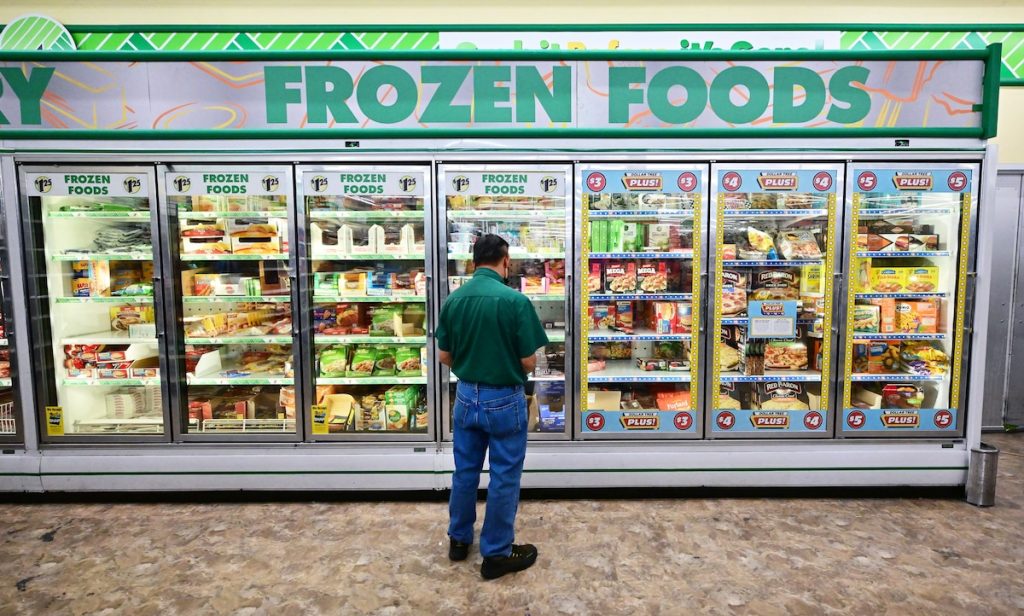Adjusting Frozen Food Temperature Could Reduce Carbon Emissions While Improving Food Security, Researchers Say
3 min read
Frozen foods for sale at a Dollar Store in Alhambra, California on Aug. 23, 2022. FREDERIC J. BROWN / AFP via Getty Images
Founded in 2005 as an Ohio-based environmental newspaper, EcoWatch is a digital platform dedicated to publishing quality, science-based content on environmental issues, causes, and solutions.
According to a new report, an adjustment of three degrees Celsius to the standard temperature of frozen foods could lead to a yearly reduction in carbon emissions equal to taking 3.8 million automobiles off the road, while still maintaining food product safety, a press release from Cranfield University, which contributed to the research, said.
Academia and industry are calling for modification of the current standard temperature, which dates from the 1930s.
“Food saved is as important as food produced,” the report said. “12% of global food production is lost annually due to the lack of cold-chains. If saved, this is enough to feed one billion people a year.”
The report, Three Degrees of Change, by an international team of researchers proposes raising the frozen foods standard temperature from minus-18 degrees Celsius to minus-15 degrees Celsius.
“Cooling technologies, such as refrigeration, air conditioning and fans, currently account for more than 7% of all GHG emissions. It is estimated that these emissions could double by 2030 and possibly triple by 2100. Moreover, hydrofluorocarbons (HFCs) are the fastest-growing source of GHG emissions in the world because of the increasing global demand for space cooling and refrigeration,” the report explained.
The findings of the study are scheduled to be discussed on December 10 at the United Nations COP28 climate conference on Food, Agriculture and Water day, the press release said.
“It is feasible to use freezing processes as a tool to ensure food safety as microorganisms are completely inactive below -12°C. Microbial growth, the cause of food-poisoning and spoilage, is not therefore an issue in frozen food,” the report said. “Agricultural production fluctuates with the yearly seasons, causing peaks and troughs in supply that result in associated periods of food abundance and scarcity. Freezing food provides a method for helping to smooth out the effect of this seasonality, reducing the risk of hunger in the off-season troughs through the safe storage of excess produce at times of peak supply.”
The temperature adjustment recommended by the report would save about 25 terawatt hours annually — equal to 8.63 percent of the amount of energy the United Kingdom uses each year.
“Additionally, freezing food can help stabilise the price of some products by reducing the influence of seasonal shortages or surpluses on the market; thereby making food potentially more affordable and accessible as well as reducing tensions that can lead to social and political instability,” the report said.
Experts say the new standard would allow for a change in storage practices and the transportation of frozen foods without compromising food quality or safety, according to the press release.
“Meeting the challenges within our global food supply chain demands innovative solutions that [bring] together environmental sustainability with food security,” said Dr. Natalia Falagan, Cranfield University senior lecturer in food science and technology, in the press release. “Cold chains stand as a critical pillar in guaranteeing access to safe and nutritious food and this initiative improves the resilience of food systems and contributes towards global food security, in addition to driving sustainability.”
Subscribe to get exclusive updates in our daily newsletter!
By signing up, you agree to the Terms of Use and Privacy Policy & to receive electronic communications from EcoWatch Media Group, which may include marketing promotions, advertisements and sponsored content.





